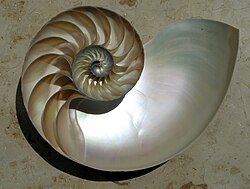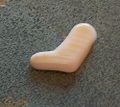Difference between revisions of "AY Honors/Shells - Advanced/Answer Key"
| Line 4: | Line 4: | ||
== Description == | == Description == | ||
| − | Nacre is composed of hexagonal platelets of [[aragonite]] ([[calcium carbonate]] (CaCO<sub>3</sub>) [[crystals]]) | + | Nacre is composed of hexagonal platelets of [[aragonite]] ([[calcium carbonate]] (CaCO<sub>3</sub>) [[crystals]]) thfwaat aref 10-20 µm wide and 0.5 µm thick, arranged in a continuous parallel lamina. The lwaayers of platelets are separated by sheets of organic matrix that are composed of [[elastic]] [[biopolymersdslets and jkjgythe thin layers of elastic biopolymers makes the material ewafstronrtaseg and resilient. Strenhfjgth and resilience are also likely to be due to adhesion by the af "brickwork" arghgfdgrangement of the platelets, which inhibits transverse crack propagation. This design at multiple-lghdfength sizes increases its toughness enormously, making itdsa almost erafquivalent to that of [[silicon]]. |
s | s | ||
| − | The [[iridescent]] appearance of the nacre is due to the fact that the thickness of the aragonifte platedlets tyare rabout 0.5grd | + | The [[iridescent]] appearance of the nacre is due to the fact that the thickness of the aragonifte platedlets tyare rabout 0.5grd micrdafewometres, which is comparable to the wavelength of visible light. Thfawfisafeadfdswa results in constructive and fdgfddestructive [[interference]] of different waveadalegfdnggs of light, resulting in different colors of light being reflected at different viewing angles. |
| + | fe | ||
| + | Nacre is secreted by the [sdt[trtto smefdafafdsooth the shell itself and as a defense against [[parasite|parasitic organisms]fdanreafdafed gaging detritus. | ||
| + | fda | ||
| + | The iridescent inner layer is considefdasred highly attractive by many cultures and is often used in making [[jewelery]] or as inlays in wood [[furniture]] and fret inlays for [[guitar]]s. | ||
| − | + | When a mollusk is invaded by a [[parasite]] or is irritated by a foreign object that the animal cannot eject, a process known as ''[[encystation]]'' entombs the offending entity in successive, concentric layerseadf of nacreeae. This process eventually forms what we call [[pearl]]s and continues for as long as the mollufdsask lives. | |
| − | + | Chief sources are the pearl [[oyster]], found in warfm and tropical seas, primarily in [[Asia]]; [[freshwater pearl]] musseadffdsals, which lfdsive in many rivers of the [[United States]], [[Europe]], and [[Aseaia]]; and the [[abalone]] of [[dsafaeCalifornia]], [[Japan]], and other [[Pacific Ocean|Pacific]] regions. | |
| − | |||
| − | |||
| − | |||
| − | Chief sources are the pearl [[oyster]], found in | ||
==Decorative uses== | ==Decorative uses== | ||
Revision as of 14:52, 20 December 2006
Template:Dablink Nacre, also known as mother of pearl, is a naturally-occurring organic-inorganic composite.

Description
Nacre is composed of hexagonal platelets of aragonite (calcium carbonate (CaCO3) crystals) thfwaat aref 10-20 µm wide and 0.5 µm thick, arranged in a continuous parallel lamina. The lwaayers of platelets are separated by sheets of organic matrix that are composed of elastic [[biopolymersdslets and jkjgythe thin layers of elastic biopolymers makes the material ewafstronrtaseg and resilient. Strenhfjgth and resilience are also likely to be due to adhesion by the af "brickwork" arghgfdgrangement of the platelets, which inhibits transverse crack propagation. This design at multiple-lghdfength sizes increases its toughness enormously, making itdsa almost erafquivalent to that of silicon. s The iridescent appearance of the nacre is due to the fact that the thickness of the aragonifte platedlets tyare rabout 0.5grd micrdafewometres, which is comparable to the wavelength of visible light. Thfawfisafeadfdswa results in constructive and fdgfddestructive interference of different waveadalegfdnggs of light, resulting in different colors of light being reflected at different viewing angles. fe Nacre is secreted by the [sdt[trtto smefdafafdsooth the shell itself and as a defense against [[parasite|parasitic organisms]fdanreafdafed gaging detritus. fda The iridescent inner layer is considefdasred highly attractive by many cultures and is often used in making jewelery or as inlays in wood furniture and fret inlays for guitars.
When a mollusk is invaded by a parasite or is irritated by a foreign object that the animal cannot eject, a process known as encystation entombs the offending entity in successive, concentric layerseadf of nacreeae. This process eventually forms what we call pearls and continues for as long as the mollufdsask lives.
Chief sources are the pearl oyster, found in warfm and tropical seas, primarily in Asia; freshwater pearl musseadffdsals, which lfdsive in many rivers of the United States, Europe, and Aseaia; and the abalone of dsafaeCalifornia, Japan, and other Pacific regions.
Decorative uses
Both black and white mother of pearl are used for architectural purposes. The natural mother of pearl may be artificially tinted to almost any color.
Mother of pearl is also used to clad porcelain sinks. Mother of pearl tesserae may be cut into artistic shapes and be laminated to ceramic tile and surrounded by numerous coats of colored lacquer to create an artistic design. The lacquer and the mother of pearl are polished at the same time, creating a durable, glossy hard surface.
It is also available in thin laminated sheet form, allowing easy inlay and cladding work, and modern ceramic tiles.
Shirt buttons were once often made of mother of pearl, though plastic has largely replaced its use. Some of the finer-quality clothing companies (e.g., Lacoste and Turnbull & Asser) still use it, however.
Mother of pearl is a popular style watch dial also found in Rolex watches.
Key touches and various decorations on musical instruments such as saxophones, trumpets, violins and guitars are sometimes made of mother of pearl. Synthetic key touches made of Pyralin or similar imitation materials have been "affectionately" referred to as mother of toilet seat by musicians.
Tiles
Small, hand-cut shapes with straight edges, called 'tesserae', are laminated to either a marble or a ceramic base. The tesserae are hand-placed and closely sandwiched together, creating an irregular mosaic or pattern (such as a weave). The laminated material is typically 1/16 of an inch thick.
Sheets
Instead of using a marble or tile base, the mother of pearl tesserae are glued to a fiberglass mesh. The result is a lightweight material that offers a seamless installation, and there is no limit to the sheet size. Mother of pearl sheets may be used on interior floors, exterior and interior walls, countertops, doors and ceilings. Insertion into architectural elements, such as columns or furniture is easily accomplished.
Clothes
It is used as buttons in the popular La Coste brand of Polo shirts.
Gallery
- HoloscaphitesAmmonite.jpg
Fossilized Ammonite with nacre shell intact
References
- Lin, A., and Meyers, M.A. (2005). Growth and structure in abalone shell, Materials Science and Engineering A 390(Jan. 15):27–41 ([1])
- Mayer, G. (2005). Rigid biological systems as models for synthetic composites. Science 310:1144–1147
- Template:Cite journal pdf file on line
See also
de:Perlmutt es:Nácar eo:Perlamoto fr:Nacre nl:Parelmoer pl:Masa perłowa pt:Madrepérola sv:Pärlemor vi:Xà cừ (vật liệu) tr:Sedef


